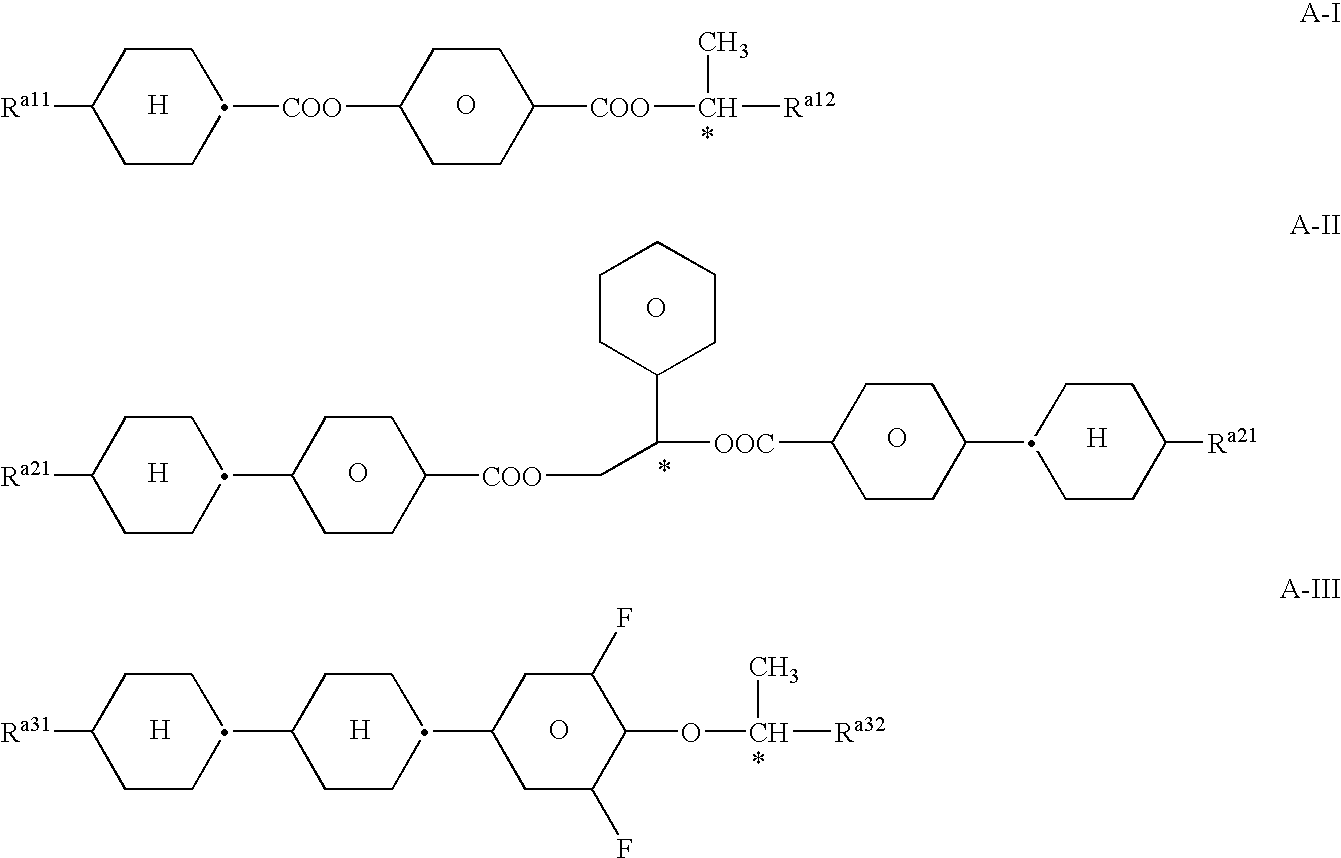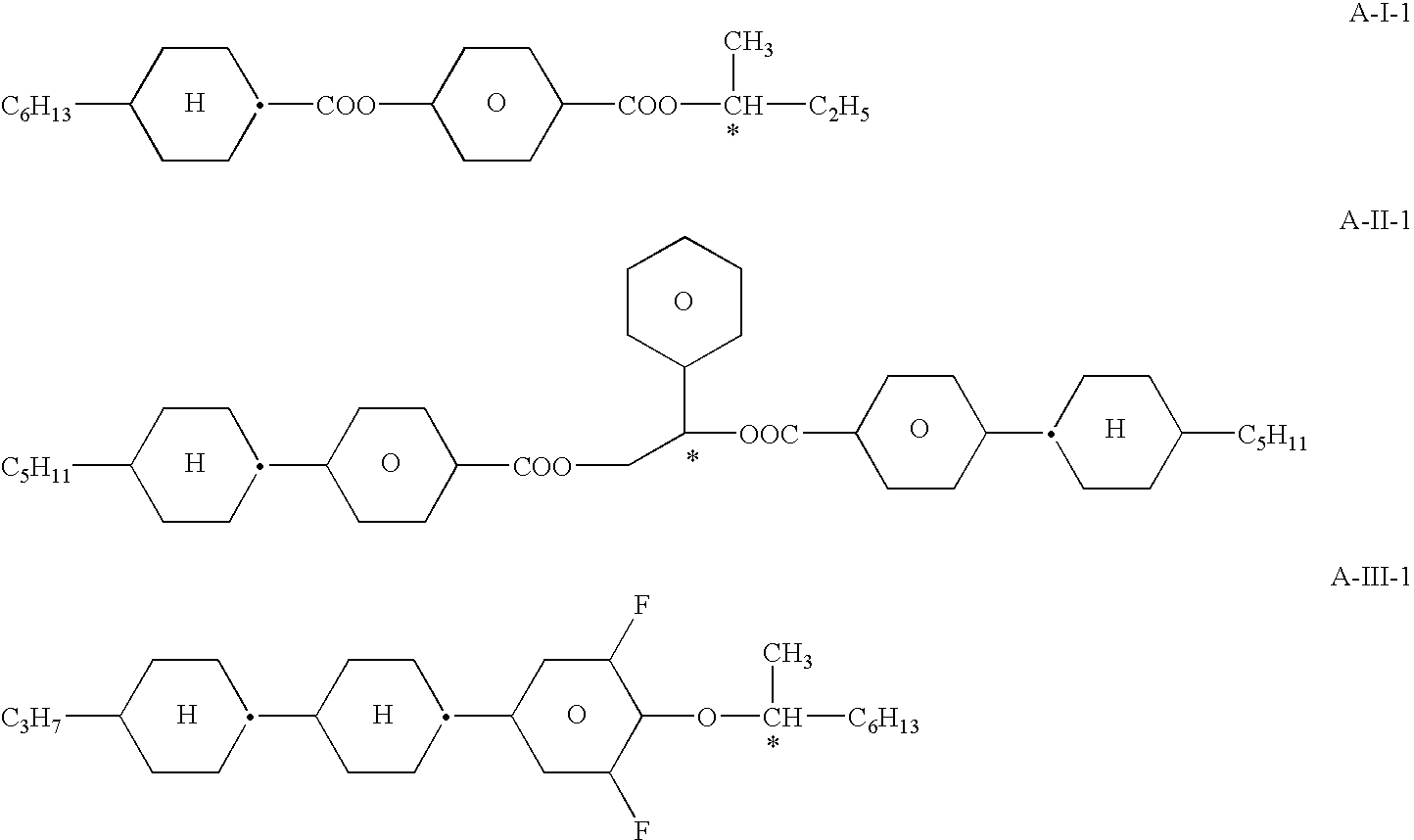Electrooptical light modulating element, electrooptical display and modulating medium
a light modulating element and light modulating technology, applied in the field of light modulation elements, can solve the problems of clear pronounced viewing angle dependence of contrast, long response time of all conventional displays, and insufficient response time, and achieve the effect of reducing temperature dependence of characteristic voltages
- Summary
- Abstract
- Description
- Claims
- Application Information
AI Technical Summary
Benefits of technology
Problems solved by technology
Method used
Image
Examples
example 1
[0292] A mixture comprising 97% of the achiral liquid-crystal mixture AM-1 of Comparative Example 1a and 3% of the chiral compound B(OC)2C*H-C-3 is prepared and investigated. The chiral compound in the form used has an HTP at 20° C. of +137 μm−1 (in MLC-6828) and +104 μm−1 in MLC-6260.
CompositionConc. / Compound #Abbreviation% by weight1B(OC)2C*H-C-33.02UZU-3A-N7.253GZU-3A-N14.554GZU-4A-N14.555GZU-4O-N14.556PU-3-AN9.77PTU-4O-N14.558CUZU-2-N14.559CUZU-3-N7.25Σ100.0Physical propertiesTchar. =11.5° C.εav.(Tchar. + 6°) =69.9V70(Tchar. + 0.5°) =23 VdV70(Tchar. + 0.5°) / dT =2 V / °dV*70( / V70) / dT =9% / °V70(Tchar. + 2°) =40 VdV70(Tchar. + 2°) / dT =20 V / °dV*70( / V70) / dT =45% / °V70(Tchar. + 2.2°) =42 V
[0293] The mixture has a blue phase over a range of about 2 degrees with the following phase sequence: N* 11.5° C. BP 13.5° C. I.
[0294] The mixture is, as described in Comparative Example 1a, introduced into a test cell and investigated as described. In particular, its electro-optical properties are i...
example 2a
[0307] A mixture comprising 90% of the achiral liquid-crystal mixture AM-2 of Comparative Example 2 and 10% of the chiral compound B(OC)2C*H-C-3 is prepared and investigated. This mixture had a characteristic temperature of 22.5° C., but 24.4° C. in the cell, which is assumed here to be the characteristic temperature. The temperature dependence of the voltage V70 is shown in the following table (Table 3).
TABLE 3Temperature dependence of the characteristic voltages ofExample 2a#T / ° C.V70 / V1−19.31562−17.31163−15.5934−13.5825−11.6806−9.6827−7.7888−5.6949−3.710210−1.9108112.0125125.9143139.7164
[0308] As can be seen from this table (Table 3), the characteristic voltage V70 of the cell containing this doped mixture does not increase with increasing temperature, as in Comparative Example 1a and Example 1, but instead initially decreases with increasing temperature, then passes through a minimum at about −11.6° C. and only then rises again with further increasing temperature. The temperat...
example 2b
[0311] 85% of the achiral liquid-crystal mixture AM-2 of Example 1 was with 15% of the dopant mixture DM-1 having the following composition.
Composition DM-1Conc. / HTP (MLC-HTPCompound% by6828) / (MLC-6260) / #Abbreviationweightμm−1μm−11B(OC)2C*H-C-328.6+137 +1042(6OPZ)2X*14.2+58n.d.3(1OPZPZ)2X*14.3+80n.d.4SS-(5CPZ)2BE14.2−56n.d.5RR-(5CPZ)2BE14.3+56n.d.6R-101114.4n.d. +27Σ100.0
Notes:
see Table 1
[0312] The chiral compounds used in the dopant mixture DM-1 all, apart from one exception, have a high, positive value of the HTP in the reference mixture having the stated composition.
[0313] For the resultant modulation medium, it was not possible to determine a clearing point or a transition into the blue phase under the microscope at temperatures down to −20° C. The mixture comprising 85% of AM-2 and 15% of DM-1 is mixed with 0.1% of the phenol of the formula
[0314] introduced into a test cell and investigated as described in Comparative Example 1a. In particular, its electro-optical proper...
PUM
| Property | Measurement | Unit |
|---|---|---|
| temperature | aaaaa | aaaaa |
| clearing point | aaaaa | aaaaa |
| clearing point | aaaaa | aaaaa |
Abstract
Description
Claims
Application Information
 Login to View More
Login to View More - R&D
- Intellectual Property
- Life Sciences
- Materials
- Tech Scout
- Unparalleled Data Quality
- Higher Quality Content
- 60% Fewer Hallucinations
Browse by: Latest US Patents, China's latest patents, Technical Efficacy Thesaurus, Application Domain, Technology Topic, Popular Technical Reports.
© 2025 PatSnap. All rights reserved.Legal|Privacy policy|Modern Slavery Act Transparency Statement|Sitemap|About US| Contact US: help@patsnap.com



